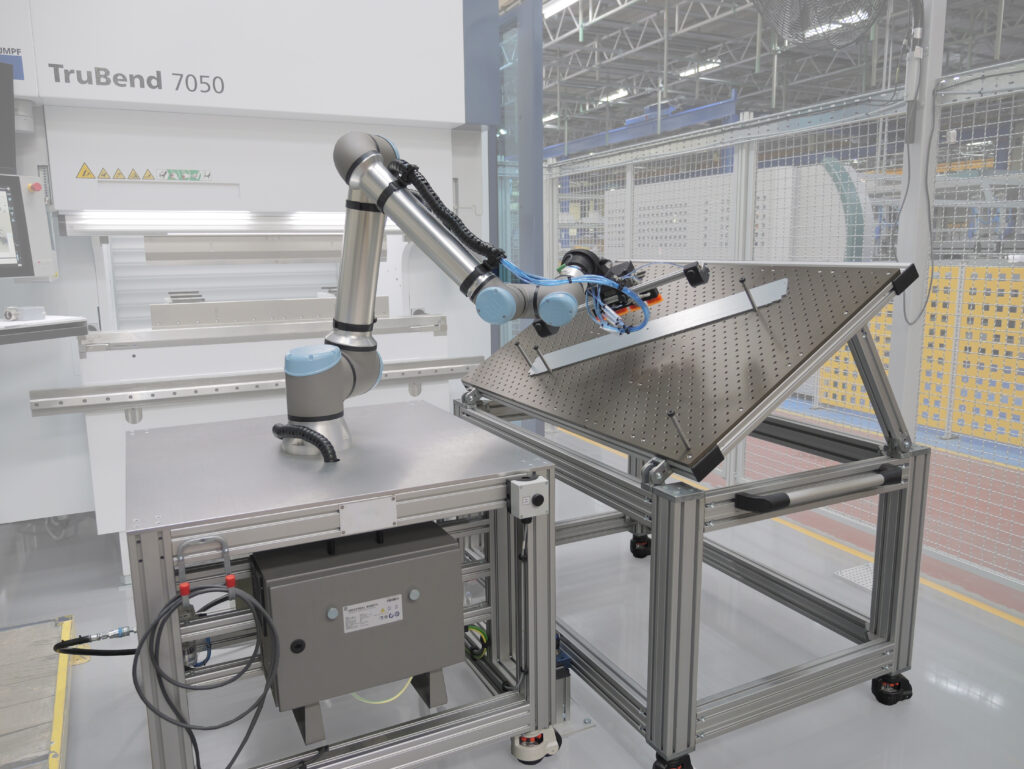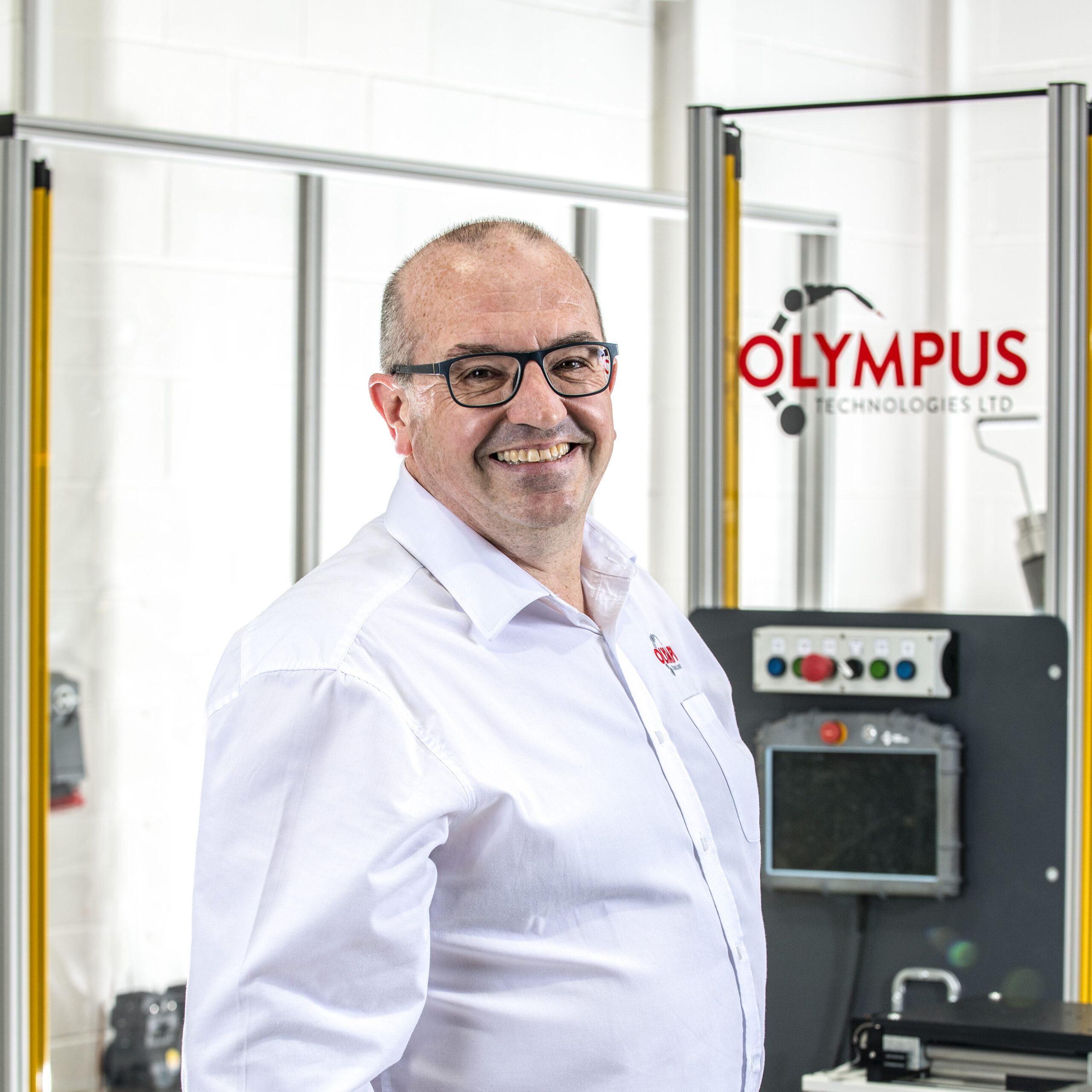The Skilled Labour Shortage in Manufacturing
Manufacturing faces a global shortage of skilled labour, particularly in trades such as machine operation, welding, and press brake operation.
Contributing factors include:
- An aging workforce
- Fewer young workers entering trades
- Rising labour costs
- High turnover in physically demanding roles
In the United States alone, Deloitte projects the labour gap could result in $1 trillion in lost output if unaddressed.
One area heavily impacted is press brake operation, a highly skilled role within metal fabrication that involves manually bending sheet metal into precise shapes.
As seasoned operators retire and new ones are scarce, manufacturers are struggling to maintain output and quality.

Collaborative Robots (Cobots) as a Labour-Saving Automation Strategy
Collaborative robots, or cobots, have emerged as a practical response to the skilled labour shortage in manufacturing.
Unlike traditional industrial robots, cobots have the capability to operate safely alongside humans, thanks to built-in safety features such as:
- Force and collision sensors
- Speed limits
Cobots are:
- Compact and easily integrated into existing setups
- Flexible, with fast programming interfaces
- User-friendly, allowing staff with minimal robotics experience to teach new tasks via manual guidance
Key Benefits of Cobots in Labour-Constrained Environments:
- Fill unstaffed positions with automation
- Run repetitive processes without fatigue
- Free up human workers for quality control and high-value tasks
- Lower cost of ownership than traditional robots
- Faster ROI, often within 6–12 months
Labour shortages are now the primary driver of collaborative automation adoption across manufacturing sectors.
Why Press Brake Operations Are Hard to Staff and Automate
A press brake bends sheet metal by clamping it between a punch and die. Skilled operation requires:
- Understanding metal thickness and bend allowances
- Tool setup and sequencing
- Physical dexterity and safety awareness
Each workpiece must be:
- Lifted, aligned, and positioned against the back gauges
- Bent, often in multiple steps
- Handled safely, especially with small parts or large sheets
These are labour-intensive, high-risk tasks that few younger workers are being trained to perform.
Industry Consensus:
All five major press brake OEMs recently identified the lack of skilled press brake operators as the top challenge facing their customers. The result is production bottlenecks, overtime demands, and quality inconsistencies.
Automation has historically been difficult because of complex setups and low-volume, high-mix production. But cobot-based bending systems are now making automation viable, even in these complex environments.
How Cobots Automate Press Brake Bending
Cobot-Powered Bending Cell Workflow:
- The cobot picks a flat sheet metal blank from a feeder or stack.
- It positions the blank at the press brake for a bend.
- The press brake performs the bend.
- The cobot removes the part and places it onto an output stack or conveyor.
Technical Features:
- Custom grippers for multiple part sizes
- URCaps software plug-ins for easy programming
- Intuitive interfaces for fast changeovers
Real-World Cobot Use Cases in Press Brake Applications
Etalex (Canada):
- Problem: A human operator spent 8 hours daily unloading bent parts.
- Solution: A UR10 cobot replaced the operator, improving safety and freeing them for higher-value tasks.
- Result: Increased job satisfaction, reduced injury risk, and no need for safety fencing due to limited floor space.
Fujita Works (Japan):
- Problem: Ongoing shortage of skilled press brake and welding workers.
- Solution: Deployed cobots for both welding and bending tasks.
- Result: Higher throughput and reduced physical strain on workers, allowing less experienced staff to manage complex jobs.
These examples show how legacy machines can be retrofitted with cobots to ease labour demands and improve process control.
Integrating Cobots Into Flexible Production Environments
Smart Factory Integration (Industry 4.0):
Cobots are being integrated into connected production lines. A typical automated bending station might:
- Receive cut parts from automated laser cutters
- Feed completed bends to robotic welding or assembly cells
- Be managed by an MES (Manufacturing Execution System)
This transforms the press brake from a bottleneck into a synchronized node in a fully digitized production ecosystem.
Flexible Deployment Across Multiple Machines:
- Mobile cobots can be wheeled between workstations (e.g., press brake in the morning, CNC machine in the afternoon)
- Many systems are plug-and-play, needing no floor layout changes
- Quick-change grippers and standardized I/O interfaces allow rapid setup
Benefits of Cobot-Based Press Brake Automation
1. Bridging the Skilled Labour Gap
Cobots fill roles that would otherwise remain unstaffed. They also allow:
- Night shifts or lights-out production
- Expansion of capacity without new hires
2. Consistent Quality and Repeatability
Cobots:
- Perform identical motions every time
- Reduce waste and rework
- Improve process traceability and job costing accuracy
3. Improved Worker Safety and Ergonomics
Cobots eliminate:
- Manual lifting of heavy sheets
- Repetitive strain injuries
- Hand crush hazards
Result: Safer, more ergonomic workplaces with fewer downtime incidents.
4. Flexible and Scalable Automation
- Fast programming for low-volume, high-mix jobs
- Offline simulation tools reduce setup time
- Suitable for both large parts and intricate bends
5. Cost Efficiency and Fast ROI
- Lower capital costs than traditional robot cells
- Short setup times and minimal training
- Typical ROI in 6–12 months, sometimes faster
How Olympus Technologies Can Help with Press Brake Automation
At Olympus Technologies, we specialise in delivering turnkey collaborative robot solutions that address today’s manufacturers' skilled labour challenges. Our expertise lies in helping companies integrate robotic press brake automation that is both flexible and cost-effective, without the need for in-house robotics expertise.
Our Press Brake Automation Solution Includes:
- Integration ofa Universal Robot UR10 or UR20 with your new or existing press brake systems
- Custom modular Scorpion Gripper with individual cup control, pinch piack and rotatable vac pick, engineered to handle a wide range of sheet metal part sizes and geometries
- Olympus Scorpion Gripper software provides intuitive control of the modular gripper via the robot teach pendant
- Modular robot cells designed for space-constrained environments including a datuming infeed station and fixed coloum stand or mobile trolley
- Mobile and compact configurations that require minimal disruption to your floor layout
We are a Certified Systems Integrator for Universal Robots and bring deep experience in collaborative applications tailored to high-mix, low-volume production environments.
Why Partner with Olympus Technologies:
- Fast deployment: Most systems are installed and operational within days
- Comprehensive support: From initial risk assessment and system design to installation, training, and post-sales service
- Proven solutions: Our cobot press brake tending systems are already in use across UK fabricators looking to scale without adding headcount
- Flexible ownership models: We offer leasing and financing options to help you achieve ROI quickly
Whether you're running a legacy press brake or investing in a new one, our team can help you deploy a safe, productive, and scalable cobot solution that reduces manual strain, fills labour gaps, and enhances your bottom line.
Frequently Asked Questions (FAQs)
1. How do cobots solve skilled labour shortages in manufacturing?
Collaborative robots (cobots) help fabricators and manufacturers address skilled labour shortages by automating repetitive and physically demanding manual operations. Cobots can perform tasks like bending, stacking, or unloading in a press brake setup, enabling your business to maintain productivity even when qualified operators are hard to find. With intuitive software and minimal training required, cobots empower companies to deploy automation quickly, reducing labour costs and improving overall efficiency.
2. What is press brake automation and how can it benefit my company?
Press brake automation involves integrating a robotic system, often a Universal Robots cobot, with your press brake machine to bend sheet metal parts consistently and safely. These automation solutions reduce cycle time, improve quality, and free human operators to focus on higher-value work. Businesses implementing robotic press brake solutions typically see better throughput, fewer errors, and a faster return on investment, especially when tackling high-mix, low-volume production.
3. Can collaborative robots be integrated into existing production lines or smaller spaces?
Yes. Collaborative robotics is designed for flexibility. A cobot mounted on a mobile stand can be moved between workstations, making it ideal for fabricators with limited space or variable job schedules. Cobots can be deployed as standalone cells or fully integrated into a connected production line, forming part of a smart factory system. These systems are scalable and modular, allowing you to maximise your investment while reducing layout changes.
4. What can I expect when deploying a robotic press brake system?
When you partner with a robotics integrator like Olympus Technologies, you can expect support for the entire project, from initial consultation and range determination to cell design, installation, software setup, and operator training. Most collaborative robots can be configured quickly with plug-and-play solutions, and once deployed, they provide consistent part quality, predictable cycle times, and enhanced machine utilisation. For many customers, ROI is achieved within 6–12 months.
5. How can my company determine if a cobot press brake solution is right for us?
To determine if a cobot-based press brake solution is the right fit, evaluate your current production volume, task mix, available skilled labour, and space constraints. If your shop frequently struggles with operator shortages or relies heavily on manual processes, automation could be the enabling technology to reduce costs, boost productivity, and expand capacity. We recommend starting with a consultation to assess your needs and identify which tasks a cobot can automate most effectively.
Conclusion: Cobots Are the Future of Resilient Manufacturing
Collaborative robots are redefining press brake operations, transforming what was once a labour-intensive bottleneck into a consistent, flexible, and scalable production capability.
Key takeaways:
- Cobots help manufacturers overcome labour shortages
- They improve safety, quality, and productivity
- They reduce costs and deliver fast ROI
- They enable human workers to focus on value-added tasks
In the era of Industry 4.0, cobot-powered automation is no longer a niche solution, it’s becoming the standard for agile, efficient manufacturing.
By adopting collaborative press brake automation today, manufacturers position themselves for long-term competitiveness, productivity, and workforce sustainability.














